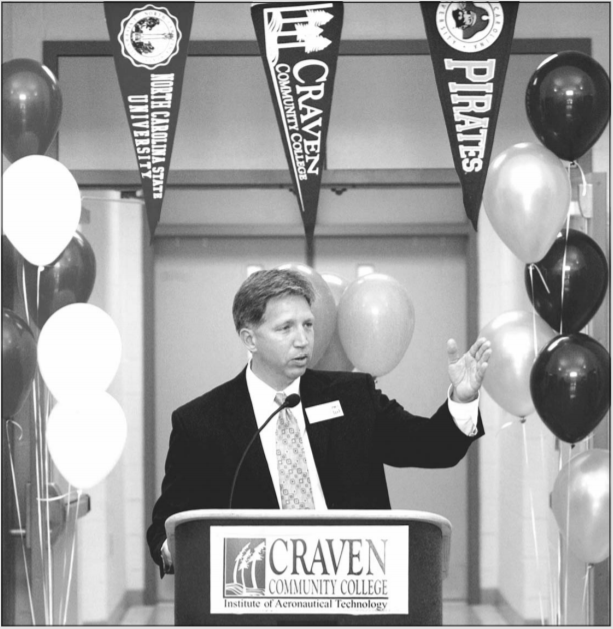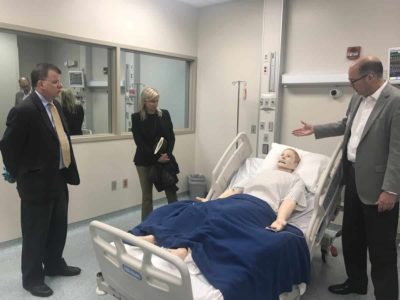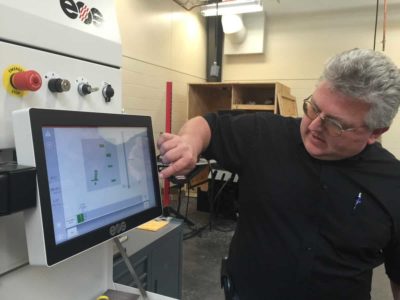

W. Dallas Herring, former Chairman of the State Board of Education, pioneered what would become the North Carolina Community College System in the 1960s, proclaiming, “We must take the people where they are and carry them as far as they can go.” Despite the vast improvements in state education levels since he articulated his vision, Herring would lament the many citizens and state leaders who do not realize the value of higher education and the peril of educational inequality in a world where what you earn is based on what you learn.
Too frequently, we assume these job losses are due to unfair trading practices and low international wages, not fully realizing that job losses are not confined to traditionally low-wage production jobs. North Carolina’s citizens must realize that skill-based technology often drives the new job inequality, suggesting that insufficient education levels should receive a portion of the blame. Indeed, growing wage differentials and trade practices distract us from what should be our greatest concern — the growing education gap between ourselves and our worldwide competitors. Thirty years ago, the U.S. had 30 percent of the world’s population of college students. By 2006, that percentage was 14 percent and dropping fast, as the proportion of individuals pursuing college education is increasing in other nations. American educational progress has stalled and even may be in reverse for the first time in our nation’s history, and North Carolina trails national education rates in many cases.
These conditions, among others, have given rise to North Carolina’s recent economic policy discussions on the potential division into two North Carolinas: rural and urban, poor and rich. Such economic disparities are seen increasingly along racial lines in rural areas, where education varies with race. Ultimately, the negative correlation between educational achievement and poverty exacerbates the division of North Carolina.
When combined with the slowing of educational levels, the increasing economic disparities along racial and poverty lines evince the ever increasing economic benefits of higher education. National Census data suggest that education is a key factor in eliminating racial economic gaps. As growth continues in careers requiring analytical and technological skills, and as the supply of college-educated workers continues to flag, wage premiums for college education increase rapidly. For men, median earnings of four-year college graduates were 19 percent higher than for high school graduates in 1975, and that gap grew to 63 percent in 2005. For women, median earnings of four-year college graduates were 37 percent higher than those of high school graduates in 1975, with the gap growing to 70 percent in 2005. Moreover, in 2003, only a third of all families headed by dropouts and one-half of families headed by high school graduates could claim middle class income status. By 2012, North Carolina will see a 24 percent increase in the number of jobs requiring some postsecondary education.
Those who are less educated in North Carolina are disproportionately more affected by layoffs. More than 20 percent of North Carolina workers displaced between January 1999 and June 2001 had less than a high school education and 59 percent had completed only high school, while only 18 percent had some college or had completed college. Ultimately, college-educated workers’ elevated earning potential shields them from layoffs, downsizing, and the lack of benefits. Unless our state’s educational leaders confront these new economic and educational realities, our next 50 years are not likely to see the same level of progress and prosperity as Herring did over the past 50.
In his seminal book, Good To Great, Jim Collins, a former faculty member at the Stanford University Graduate School of Business, suggests that a dominant characteristic of great companies is their willingness to confront the brutal facts of reality. A fact that all North Carolinians face today is that we compete in a world market that is much more competitive than it was just 10 years ago. We also face the likelihood that progress over the next 50 years will greatly depend on our state’s ability to confront new educational realities in this rapidly changing economic context. The four brutal facts that must first be recognized before we can introduce innovations to our educational system and modify our perspective of community colleges’ role in our economic future are the following:
Brutal Fact #1: The Emerging “Nontraditional” Student and the Vanishing African American Male Student:
Nationally, only 20 percent of undergraduate students conform to the traditional stereotype of a recent high school graduate enrolled as a full-time residential student. More “nontraditional” students are the new norm, including students who are older, work full-time, take classes part-time, or have children. The 72 percent national increase in undergraduate students over the past 35 years has been caused primarily by an influx of nontraditional students, with community colleges chosen as their most common educational path. The more nontraditional a student, the more likely they are to attend a community college, with 64 percent of highly nontraditional students attending a community college.
At the same time that nontraditional community college undergraduates are filtering into postsecondary ranks, African American males are vanishing. In the 2006–07 academic year, there were only 16,885 African American male community college degree students in North Carolina, and the number of African American male community college graduates has declined each of the past three years while the benefits of education are rapidly growing. In order to combat the division into two North Carolinas, our state must address this predicament.
Brutal Fact #2: Facing the Consequences of North Carolina’s Community College Completion Rates and the Costs of Remediation:
Increasing postsecondary enrollment is necessary but not sufficient to the task of fending off two North Carolinas and bolstering the economy; the state must also retain those enrolled students. In order to understand the brutal fact of low completion rates in community colleges, one must first understand that “community colleges often serve students who have the fewest options and the greatest challenges” — 61 percent of U.S. community college students are part-time, 57 percent work more than 20 hours per week, 34 percent spend 11 or more hours per week caring for dependents, and 21 percent spend between six and 20 hours per week commuting to and from class.
Among nontraditional community college students nationwide, 46 percent leave in their first year (48 percent in North Carolina) compared with 23 percent of traditional students. Of those classified as “highly nontraditional,” 62 percent leave within three years without obtaining a degree, compared to 19 percent of the minority of “traditional” community college students. Overall, non-traditional students with at least two risk factors complete their programs at a rate of less than 15 percent, compared to 57 percent of traditional students.
Nationwide, community college completion rates improve while North Carolina’s worsen, a condition brought on by five primary factors: the lack of intent to earn a degree, work recruitment prior to graduation, financial pressures, inability to qualify for financial aid, and a lack of academic preparedness. With regard to financial pressures, data from the American Council on Education indicate that while they are the most likely to benefit, community college students are the least likely to apply for financial aid, with 37 percent of all students and 22 percent of the lowest-income students not applying for any form of aid in 2003–04.
The lack of academic preparedness is of great concern in that taxpayers often end up “paying double” for high school graduates to take remedial courses before working on college credits. Since 1999–2000, the percentage of North Carolina community college students requiring remediation has ranged from 48.6 percent to 54.3 percent.
Brutal Fact #3: North Carolina’s Looming Work Force Shortage, the Emerging Role of Immigrants, and the Consequences of Low College-Going Rates:
Between 2006 and 2016, North Carolina’s population is predicted to increase by 15 percent, compared to an overall U.S. growth rate of 9 percent. Demographic trends suggest that this significant growth will heighten work force shortages rather than alleviate them.
So where will we find the workers to provide the necessary health care and other services for a booming retirement population? During the 1990s, 13.65 million new immigrants arrived in the U.S. During this period, no state has seen a greater percentage influx in foreign immigration than North Carolina, with a 273 percent increase in our foreign-born population. During the 1990s, our Asian population increased by 128 percent and our Hispanic/ Latino population increased by 394 percent. With the significant increase in foreign immigration to North Carolina, and the beginnings of labor shortages in a number of occupational areas, the foreign-born immigrant population has assumed an increasingly prominent role in the North Carolina work force.
An obviously troubling aspect of the rapid growth in immigration has been illegal immigration to the United States. Between 2000 and 2005, an estimated 4.1 million new immigrants arrived in the U.S., accounting for 86 percent of the net increase in employed persons, which is the highest share in U.S. recorded history. The rapid growth in illegal immigration has charged the current national political landscape perhaps more than any other single issue. For example, the U.S. Senate voted down the Secure Borders, Economic Opportunity and Immigration Reform Act of 2007, despite a strong endorsement from Republican President George W. Bush and leaders in both major political parties. It is an issue that is particularly emotional in states like North Carolina, which have simultaneously dealt with significant job losses due to foreign competition and the rapid influx of new foreign-born workers.
In December 2007, North Carolina community colleges found themselves in an unusual place — at the center of the national immigration debate and on the front page of many newspapers across the state. The issue at hand was a legal interpretation by the attorney for the N.C. Community College System that local campuses did not have the authority to deny admission to students based on their immigration status. Previously, 22 of the system’s 58 colleges had adopted local policies to bar undocumented applicants, while admission policies at the other 36 community colleges only distinguished between in-state and out-of-state residents. At those campuses, undocumented immigrants could be admitted under the same guidelines as international and other out-of-state residents, paying out-of-state tuition rates that exceed actual state costs.
Previously, in the 2005–06 legislative session, the General Assembly had considered a proposal (House Bill 1183) that would have provided in-state college tuition rates to immigrant graduates of North Carolina high schools who expressed intent to become U.S. citizens, but whose parents entered North Carolina illegally. Ten states have already passed such legislation.
Admission of undocumented immigrants is obviously a legal issue, and for many North Carolinians it is understandably an emotional one, as many native residents see inequity in offering jobs and services, while long-time taxpaying citizens see record numbers of pink slips. But as Governor Mike Easley has recently pointed out, it is also a “business issue” that creates a brutal economic dilemma with respect to our educational investments.
On the one hand, in addition to the law and-order argument, those who oppose the admission of illegal immigrants to community colleges can ask a number of valid questions from strictly an economic perspective. When there are so many community college resource needs, why should we utilize our limited resources to educate illegal immigrants? When we already face classroom space limitations and waiting lists for some programs, how can we risk limiting opportunity to North Carolinian citizens? Finally, given the community college work force development mission, why invest resources in individuals not legally eligible to participate in North Carolina’s work force?
On the other hand, there exists our brutal economic dilemma. Given current demographic trends, immigration policies, and enforcement of policies under current law, new immigrants to our state — including undocumented immigrants — are part of our current work force. Absent a significant change in immigration policy, they will play an increasing role in our future work force. Consequently, our state faces a challenging question on a macro-level similar to one posed to a business leader who, given the mobility of current workers, was asked the question, “What if I train them and they leave?” His response: “What if they are not trained and they stay?”
Brutal Fact #4: Balancing Rising Enrollments, Lagging Faculty Salaries, and Inadequate Equipment Funds with Expanding Needs for Graduates:
Increased enrollment pressures community colleges’ resources at a difficult time. North Carolina’s community colleges cannot remain competitive with either other community colleges nationally or with other postsecondary institutions in our state with regard to teacher salaries and equipment. Increasing community college faculty salaries to national averages would require $77.3 million between 2007 and 2010, while the necessary equipment replacements would cost more than $47 million. Without the necessary funding increases, the work force and economic development consequences of uncompetitive salaries and outdated equipment manifest themselves in the elimination of high-cost vocational and technical programs that could provide well-paying jobs. In addition, community colleges should not just be keeping pace with today, but also should be preparing for tomorrow, such as in developing programs to address North Carolina’s current nursing shortages.
In order to ensure that our next 50 years are as productive and beneficial as our last 50, North Carolina’s leaders must not only recognize these brutal facts, but also act to enable community colleges to provide the access and opportunity capable of bridging the education and economic gaps that threaten to divide our state.
See the full report here.




